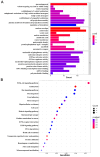Comprehensive Analysis of Methylome and Transcriptome to Identify Potential Genes Regulating Porcine Testis Development
- PMID: 39201790
- PMCID: PMC11354776
- DOI: 10.3390/ijms25169105
Comprehensive Analysis of Methylome and Transcriptome to Identify Potential Genes Regulating Porcine Testis Development
Abstract
DNA methylation plays a critical role in regulating gene expression during testicular development. However, few studies report on candidate genes related to the DNA methylation regulation of porcine testicular development. This study examined the differentially expressed genes (DEGs) and their methylation levels in testicular tissues from pigs at 60 days of age (60 d) and 180 days of age (180 d) using RNA-Seq and whole genome bisulfite sequencing (WGBS). It was determined that DNA methylation primarily occurs in the cytosine-guanine (CG) context, and the analysis identified 106,282 differentially methylated regions (DMRs) corresponding to 12,385 differentially methylated genes (DMGs). Further integrated analysis of RNA-Seq and WGBS data revealed 1083 DMGs negatively correlated with the expression of DEGs. GO analysis showed that these genes were significantly enriched in spermatogenesis, germ cell development, and spermatid differentiation. The screening of enriched genes revealed that hyper-methylation repressed ADAM30, ADAM3A, DPY19L2, H2BC1, MAK, RPL10L, SPATA16, and YBX2, while hypo-methylation elevated CACNA1I, CADM1, CTNNB1, JAM2, and PAFAH1B3 expression. Additionally, the methylation status of the key genes ADAM3A, ADAM30, YBX2, JAM2, PAFAH1B3, and CTNNB1 was detected by bisulfite sequencing PCR (BSP). This study offers insights into the epigenetic regulation mechanisms underlying porcine testicular development.
Keywords: DNA methylation; RNA-Seq; WGBS; porcine; testicular development.
Conflict of interest statement
The authors declare no conflict of interest.
Figures






Similar articles
-
Analysis of DNA methylation profiles during sheep skeletal muscle development using whole-genome bisulfite sequencing.BMC Genomics. 2020 Apr 29;21(1):327. doi: 10.1186/s12864-020-6751-5. BMC Genomics. 2020. PMID: 32349667 Free PMC article.
-
Integrative DNA methylome and transcriptome analysis identify potential genes on the influence of dilated cardiomyopathy-associated heart failure.Clin Epigenetics. 2025 Apr 28;17(1):64. doi: 10.1186/s13148-025-01876-2. Clin Epigenetics. 2025. PMID: 40296161 Free PMC article.
-
The Integration of Genome-Wide DNA Methylation and Transcriptomics Identifies the Potential Genes That Regulate the Development of Skeletal Muscles in Ducks.Int J Mol Sci. 2023 Oct 23;24(20):15476. doi: 10.3390/ijms242015476. Int J Mol Sci. 2023. PMID: 37895154 Free PMC article.
-
Integrated analysis of the DNA methylome and RNA transcriptome during the development of skeletal muscle in Duroc pigs.BMC Genomics. 2024 May 22;25(1):504. doi: 10.1186/s12864-024-10404-0. BMC Genomics. 2024. PMID: 38778260 Free PMC article.
-
Regulation of DNA methylation during the testicular development of Shaziling pigs.Genomics. 2022 Sep;114(5):110450. doi: 10.1016/j.ygeno.2022.110450. Epub 2022 Aug 19. Genomics. 2022. PMID: 35995261
Cited by
-
The molecule events expression of TGF-β/Smad signaling pathway in morphological and structural developmental characteristics of gonads in goose embryos.Poult Sci. 2025 Feb;104(2):104808. doi: 10.1016/j.psj.2025.104808. Epub 2025 Jan 11. Poult Sci. 2025. PMID: 39823842 Free PMC article.
References
-
- Liu M., Xu Q., Zhao J., Guo Y., Zhang C., Chao X., Cheng M., Schinckel A.P., Zhou B. Comprehensive Transcriptome Analysis of Follicles from Two Stages of the Estrus Cycle of Two Breeds Reveals the Roles of Long Intergenic Non-Coding RNAs in Gilts. Biology. 2022;11:716. doi: 10.3390/biology11050716. - DOI - PMC - PubMed
MeSH terms
Grants and funding
- 2023M731039/China Postdoctoral Science Foundation
- 2022021302024853/Wuhan Science and Technology Major Project on Key techniques of Biological Breeding and Breeding of New Varieties
- 32102527/National Natural Science Foundation of China
- 2022ABA002/Hubei Provincial Science and Technology Major Project of China
- CARS-35/National Pig Industry Technology System
LinkOut - more resources
Full Text Sources
Miscellaneous

